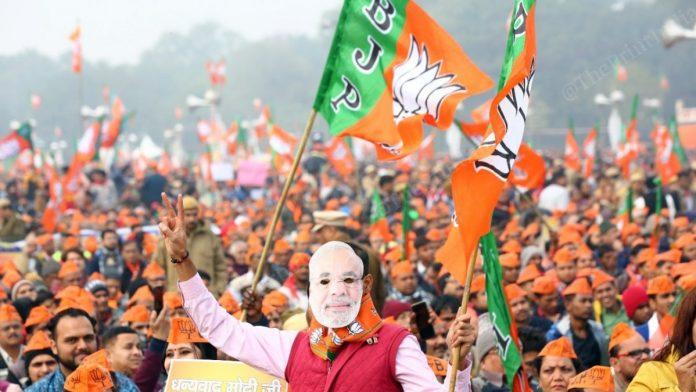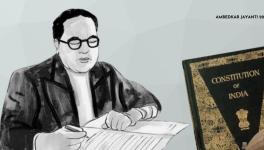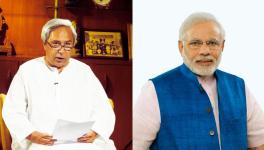How BJP’s Socio-Cultural Vision is Driving its Economic Policies

The response of the Bharatiya Janata Party-led National Democratic Alliance government to the Covid-19 pandemic lays bare the structural change that it has been bringing about in the economic realm since 2014. Many see these changes as a result of the regime’s ignorance of the composite structure of the Indian economy. In fact, it is possible to argue that this government’s economic policies stem from its ideological tenets, which favour the uniformity and dominance that it has been introducing in the socio-cultural realm. The aggressive push for a single national market for all goods and services is a pertinent example.
Similar to its socio-cultural project of constructing a singular hegemonic (read, exclusionary Hindu and upper caste) identity, which is at odds with the constituent particularistic identities of the nation, the structural change put into action in the economic sphere is rendering India’s layered and complex economy hegemonic. Notably, the regime’s underlying ideology goes against the principles of inclusion, diversity and compassion, which mark the Indian ethos.
In the same vein, the economic approach of the government works against the interests of small enterprises and the informal economy which, for starters, is enduring the pain of formalisation in the form of increasing compliance costs.
Even what appears to be an effort to formalise the economy is, on closer examination, a push for overtly centralised decision-making, which restricts the survival and growth-potential of smaller players. Further, the safeguards protecting the interests of labour are being scuttled. Scholars argue that the Union government’s economic policies are aimed at either centrally mediating all regional grievances or abandoning the concerns of smaller stakeholders. The policy bent is such that it enables the unbridled operation of businesses, generally big corporations.
The overarching economic policy edifice of the current ruling dispensation is rooted in a supply-side view of economic matters and adherence to fiscal “discipline”. This clearly implies a conservative policy posture, in which any large-scale state intervention is ruled out. That said, even within this conservative framework, a “minimum government” has to have strong state capacity to achieve “maximum governance”.
Our argument is that privileging supply-side measures over demand-boosting policy actions does not only benefit just a handful of constituencies, more importantly, it does not guarantee output recovery in a slowing economy. Second, the government does not possess enough state capacity to accomplish the structural changes that are consequential for the life chances of a wide cross-section of the population, and that the government shows no enthusiasm in augmenting state capacity to deliver on that front. Finally, there is a consonance between the government’s ideological tenets and its economic approach, and we spotlight how the electoral fallout of this is being managed.
Why government is not stepping up public expenditure:
On 12 May, Prime Minister Narendra Modi announced the ambitious Rs. 20 lakh crore ABA or Atmanirbhar Bharat stimulus package. This was the government’s policy response to the economic consequences of the Covid-19 crisis. The excitement around the sum was short-lived, for it was soon adequately established that the actual fiscal outgo towards relief and recovery is a minuscule 10% of the total package, or a little over 1% of the GDP for 2019-20. The package is grossly insufficient to have any meaningful impact on livelihoods and the economy, given the impact the pandemic portends to have.
The Union government has received flak for being parsimonious at a time when it is not supposed to be. One popular counter argument is that the Union government could not deliver a large fiscal stimulus in the ABA package because it does not have enough fiscal space due to a slowing economy, poor tax collections and increased market borrowings to bridge the burgeoning fiscal deficit. Yet, the economic predicament we are grappling with is a cumulative effect of self-inflicted policy mistakes, such as demonetisation and a hastily-implemented and federally-restrictive Goods and Services Tax (GST) regime. The pandemic and lockdown only aggravated the situation.
Equally critical is the fact that economic factors alone cannot explain the pronounced reluctance of the current ruling dispensation to substantially step up public expenditure. This reluctance is especially odd considering the window to borrow directly from the RBI could have been activated for monetising the deficit in an hour of crisis. The government is not going all out to revive the economy through public spending both on account of its ideology, and due to weak state capacity.
Unwavering commitment to supply-side economics:
The classic Keynesian prescription for an economy that has to fight its way out of a slump is that the government must do whatever it takes to stimulate it, such that consumer demand is boosted, thereby ensuring output recovery. The chorus in favour of large-scale cash transfers to poor households, to help them cope with the economic shock of the stringent lockdown emerges from this world-view, which is focused on the demand side.
But it is entirely possible that the Centre simply does not subscribe to this view. Three perceptible tendencies, anchored in supply-side theory, offer us a peek into its economic world-view. First, since demonetisation, there has been an acute demand compression in rural India and the GDP growth rate has slackened for three consecutive financial years (2017-18 to 2019-20). Despite this objective reality, this regime did not launch any special package nor adopted an expansionary fiscal policy to address the demand constraint in the economy.
Second, of late, the Centre has indicated that individuals and firms should do the heavy-lifting to revive the slowing economy. In September 2019, amidst a continued demand slowdown, the government lowered the corporate income tax rates to incentivise private investment. The Union Budget 2020-21 instituted a new personal tax regime for individual taxpayers, which intended to leave the salaried classes with higher discretionary income to boost consumption. The marquee item in the latest economic stimulus package is the collateral-free Rs. 3 lakh crore Emergency Credit Line Guarantee Scheme for all businesses, including MSMEs.
Third, Union Finance Minister Nirmala Sitharaman announced a set of “reform” measures on 17 May, as part of the stimulus package, with the stated objective of putting the Indian economy on the road to recovery. The measures include raising FDI limits in defence production, opening the coal sector to private participation, etc. These steps, the government hopes, will attract investments for building Atmanirbhar Bharat.
Demand-side interventions by the government in rural India could have had the direct effect of raising the purchasing power of both producers and wage labourers, whose sheer numbers constitute a market that is large enough to stimulate output recovery in a slowing economy. On the other hand, there is no guarantee that tax concessions for the numerically small salaried class, which accounts for a large share of private consumer expenditure, will necessarily translate into increased demand for consumer goods. For, this class always has the option of saving the extra money.
The downside to the large corporate tax cuts and loan guarantees is that they might not generate new investment if the private sector is pessimistic about the dynamism of the economy. Available evidence confirms this hypothesis.
Weak state capacity—chink in supply-side policy toolkit:
The supply-side view of economic growth is ubiquitously shared by governments across the world; the Indian government is no outlier. There is a vestige of truth in this argument, but it has to be unpacked. Even within the range of supply-side measures that are available to promote growth, over the last six years, the Centre has chiefly prioritised measures that require minimal state intervention. The continuous emphasis on improving the “ease of doing business”, by relaxing labour laws and FDI norms is one such instance. In fact, it has actively refrained from tasks that demand a tremendous amount of state capacity.
Even if one adopts a limited definition of state capacity, to encompass the enforcement of rule of law, delivery of public goods and provision of social security, there is no visible effort to ramp up the tax capacity or mobilise the required human resources even for these tasks. Public sector employment across all levels of government has been steadily declining in India since 1991 and the number of public employees per 1,000 population is one of the lowest in the world. The government’s callous attitude towards Anganwadi and ASHA workers, who are at the front-lines of delivering the most essential public services, indicates its unwillingness to invest in augmenting state capacity.
Public investment in education and health require the state to spend in ways that guarantee bang for the buck. Only a state with a well-developed capacity can take on such a role. The woefully low share of public expenditure on these items as a percentage of GDP over the years suggests that the current government is diffident about its own capacity to upscale the provision of public goods. For instance, the central government had to impose the world’s most stringent lockdown when the pandemic was at a very early stage in India. This was precisely because the public health infrastructure is least equipped to deal with an emergency.
Liquidity enhancement measures and credit guarantee schemes announced in the stimulus package are supply-side measures that not only do not require high levels of state capacity, they also kick the can down the road. It is so because the fiscal burden for the government in the event of large-scale loan defaults will take time to accrue (given the repayment schedule), and when it does, the task of recapitalising the banks can be distributed over several financial years. This raises serious concerns about the Union government’s economic competence.
Decoupling long-term outcome from short-run policy response:
Although the lockdown negatively impacted both supply and demand, reviving economic activity in the short run is possible only by raising the purchasing power of people. Such a revival has the potential to place the economy on a higher long-run growth path. Unfortunately, the government has once again reposed faith in the power of supply-side “structural reforms” to revive the economy in the long run. The pretext of making India self-reliant aside, this strategy shows its utter disregard of the immediate problems plaguing the economy. It is behaving as though the immediate has no relevance to the future course of the economy.
In his 1923 book “A Tract on Monetary Reform”, Keynes, arguably the most influential Anglo-Saxon economist of the twentieth century, observed that the “...long run is a misleading guide to current affairs. In the long run, we are all dead”. To Keynes, short term improvements in social welfare held a higher priority than long term reform that might never bear fruit. Perhaps one can hope that it is still not too late for the government to draw upon this wisdom and change its grand design to first protect the most vulnerable from the on-going storm, so that they will survive to see the ocean flat again. However, given that the government’s economic policies are strongly rooted in its ideological determinism, this hope hangs precariously.
Reconciling the impact of economic policy and electoral politics:
The fallouts of its conservative and exclusionist economic policy have put a considerable chunk of the population under distress. Yet the electoral outcomes tell a different story. The BJP under Modi has managed to pull this off by employing an exclusionary variant of nationalist-populism and exploiting the differential growth outcomes across lower caste groups.
The NDA secured an emphatic victory in the 2014 and 2019 general elections. The magnitude of these victories is analogous to the electoral sweeps last seen in the 1980s. (A populist leader is also at the helm since 2014.) However, these polls were fought on significantly different pivots. While 2014 was fought on “vikas” or development, in 2019, “vishwas” or trust was the campaign mantra.
Further, between 2014 and 2019, the BJP started trying to decouple economic performance from elections. The overt politicisation of the Hindu identity, which has a strong upper caste undertone, was foregrounded on one hand and the internal differences within and between lower castes were accentuated to prevent any counter-mobilisation. The extent to which this decoupling had succeeded became conspicuous in the 2019 election results. The downward slide of the economy did not seem to be a parameter for a considerable section of the population while it voted. This completes the full circle of the interplay of ideology and economic policy, whose design cannot help but exclude and affect a considerable chunk of the nation’s own people.
Raghunath Nageswaran is an independent researcher based in Chennai. Vignesh Karthik KR is a doctoral researcher at King’s College London. The views are personal.
Get the latest reports & analysis with people's perspective on Protests, movements & deep analytical videos, discussions of the current affairs in your Telegram app. Subscribe to NewsClick's Telegram channel & get Real-Time updates on stories, as they get published on our website.
























